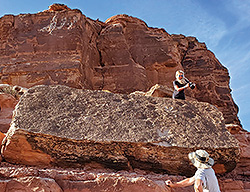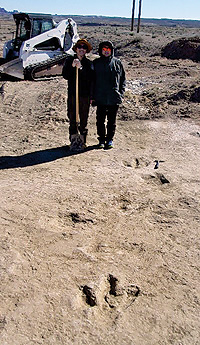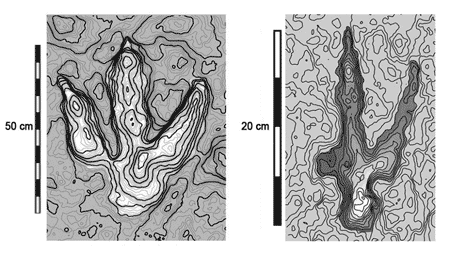 In this People in Paleo series, I have mentioned many professional paleontologist colleagues who have been active in the Dinosaur Diamond area in recent decades. We share a common knowledge of the important fossil bone and track sites and have often worked together to document them. I think it is fair to say that my colleagues regard me as the “tracker guy” and while I regard many of them as “bone people” we have often teamed up to describe tracksites, which I hasten to add are very abundant in the Moab area. This is in part because an animal only has one skeleton, but it can potentially make millions of tracks in a lifetime. It is also often easier to find tracks on surfaces representing ancient landscapes, than in is to find bones that are buried ‘inside’ rock layers. This leads to the habit of excavating bones and putting them in museums while large tracksites are left in place where they can be seen: e.g., tracksite destinations in the Moab Area include the Poison Spider, Willow Springs, Stomping Ground, Fisher Mesa and Mill Canyon sites. I call this interpretation-in-place process the making of bits of ancient landscape into parts of the modern educational-cultural landscape. In this People in Paleo series, I have mentioned many professional paleontologist colleagues who have been active in the Dinosaur Diamond area in recent decades. We share a common knowledge of the important fossil bone and track sites and have often worked together to document them. I think it is fair to say that my colleagues regard me as the “tracker guy” and while I regard many of them as “bone people” we have often teamed up to describe tracksites, which I hasten to add are very abundant in the Moab area. This is in part because an animal only has one skeleton, but it can potentially make millions of tracks in a lifetime. It is also often easier to find tracks on surfaces representing ancient landscapes, than in is to find bones that are buried ‘inside’ rock layers. This leads to the habit of excavating bones and putting them in museums while large tracksites are left in place where they can be seen: e.g., tracksite destinations in the Moab Area include the Poison Spider, Willow Springs, Stomping Ground, Fisher Mesa and Mill Canyon sites. I call this interpretation-in-place process the making of bits of ancient landscape into parts of the modern educational-cultural landscape.
 In this last of the 2022 series, I introduce Adrian Hunt with whom I teamed up to write Dinosaur Tracks and other fossil footprints on the western USA. One day he told me that he had thought I was crazy when I claimed there were tracksites everywhere. He changed his mind when we found four new sites in a single afternoon. He went on to become the director of the New Mexico Museum and Natural History, and Science and with his colleague Spencer Lucas has in the last 25 years documented a huge number of Permian and Triassic and footprint sites, many in New Mexico. They claim I infected them with the tracking bug. I am happy to take credit! A little closer to the Dinosaur Diamond trackers have demonstrated that southern Utah including San Juan County, Lake Powell and Washington County are extraordinarily tracksite rich: for example, 120 sites were found at Lake Powell in just a few years. In this last of the 2022 series, I introduce Adrian Hunt with whom I teamed up to write Dinosaur Tracks and other fossil footprints on the western USA. One day he told me that he had thought I was crazy when I claimed there were tracksites everywhere. He changed his mind when we found four new sites in a single afternoon. He went on to become the director of the New Mexico Museum and Natural History, and Science and with his colleague Spencer Lucas has in the last 25 years documented a huge number of Permian and Triassic and footprint sites, many in New Mexico. They claim I infected them with the tracking bug. I am happy to take credit! A little closer to the Dinosaur Diamond trackers have demonstrated that southern Utah including San Juan County, Lake Powell and Washington County are extraordinarily tracksite rich: for example, 120 sites were found at Lake Powell in just a few years.
Besides the tracksite destinations around Moab it is worth noting that the Moab Giants Museum has a big emphasis on tracks. This is appropriate, and part of the reason the museum was created is that the Moab area has been known for its dinosaur tracks at least since the 1980s. This is in part thanks to finds by local residents. In 2021 I and my tracker colleagues formally described several dozen new tracksites in the Dinosaur Diamond, and just this year we have found several dozen more. The Mill Canyon site and the Stomping Ground site which we described (as well as the St. George site in Washington County) occupy three of the top eight positions in the USA tracksite rankings.
A number of Dinosaur Diamond Tracksites were found by local Moab residents, others were found by myself and members of our University of Colorado, Denver Dinosaur Trackers group. While professional-amateur collaboration is great, it does not require professional training to find tracksites, a combination of luck and persistence pays off. Moab and Dinosaur Diamond residents who caught the tracking bug are too numerous to mention, but I make the exception for the Late Fran Barnes of Moab who wrote two books on tracks: Dinosaur Tracks and Trackers, and Footprints on the Shores of Time. I am grateful to him for his persistence and all other tracker friends for sharing their finds, which encourages me to return to Moab again and again.
The most conspicuous tracks at the Poison Spider site represent Early Jurassic three-toed theropods. The block fell down from the top of the cliff to expose tracks buried for 180 million years. This is one of six local tracksite destinations on public land with interpretative signs provided by the Bureau of Land Management (BLM) and the USDA Forest Service. Our tracker group documented most of them.
Trackers from the University of Colorado Denver team helped excavate the Mill Canyon Dinosaur Tracksite, in 2014. The three toed 112-million-year-old Lower Cretaceous tracks have been attributed to the large carnivore Acrocanthosaurus. The site is open to the public. 
A 3D image of a presumed Acrocanthosaurus track (left) from the Mill Canyon Dinosaur Tracksite is ~ 20 inches (50 cm) long. The small , 8-inch (20 cm) long, two toed track of a small raptor track (right), may have been made by a Velociraptor-like species. Utahraptor lived at this time, but tracks of adults would have been larger.
|